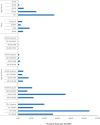Trends in Uterine Cancer Mortality in the United States: A 50-Year Population-Based Analysis
- PMID: 37678887
- PMCID: PMC10510793
- DOI: 10.1097/AOG.0000000000005321
Trends in Uterine Cancer Mortality in the United States: A 50-Year Population-Based Analysis
Abstract
Objective: To analyze mortality trends in uterine cancer in the United States over 50 years with an emphasis on age and race and ethnicity.
Methods: Data on uterine cancer deaths from 1969 to 2018 were obtained from the National Center for Health Statistics. Trends were examined by age and race and ethnicity after adjustment for the hysterectomy rate and pregnancy.
Results: Uterine cancer mortality decreased between 1969 and 1997 (from 6.03 to 4.00/100,000) but increased between 1997 and 2018 (from 4.00 to 5.02/100,000). From 2001 to 2018, mortality rates increased by 1.25-fold across all age groups. In 2018, the mortality rate from uterine cancer for patients aged 70 years or older and 60-69 years was sixfold and threefold higher, respectively, than in younger patients (aged 50-59 years) (54.87/100,000 vs 27.80/100,000 vs 8.70/100,000). The mortality rate for non-Hispanic Black women was 2.2-fold higher than for non-Hispanic White, Hispanic, and non-Hispanic Asian or Pacific Islander women (17.6/100,000 vs 7.82/100,000, 6.54/100,000, and 4.24/100,000, respectively). On an intersection analysis of age and race, non-Hispanic Black women aged older than 60 years had a threefold higher mortality rate than non-Hispanic White women (72/100,000 vs 24/100,000). A notable finding was that young non-Hispanic Black and Hispanic women (30-39 years) had the highest annual increases in mortality at 3.3% and 3.8% per year compared with 2.2% in non-Hispanic White women.
Conclusion: Since 2001, the uterine cancer mortality rate has increased across all four racial and ethnic groups examined, with the highest increase seen among non-Hispanic Black women. The largest increase in mortality was observed among younger non-Hispanic Black and Hispanic women.
Copyright © 2023 The Author(s). Published by Wolters Kluwer Health, Inc.
Conflict of interest statement
Financial Disclosure John Chan reports receiving funding from AstraZeneca, Glaxosmithkline, Immunogen, and Myriad for his efforts in this study. He also reports receiving direct payments from AstraZeneca, Eisai, Glaxosmithkline, Genmab/Seagen, Agenus, Immunogen, Merck, Mersana, MTTI, Myriad, and Roche. He has also received research funding from the Denis Cobb Hale Chair, the Angela Wang Johnson Fund, and the Fisher Family Funds. The authors did not report any potential conflicts of interest.
Figures




References
MeSH terms
LinkOut - more resources
Full Text Sources
Medical

